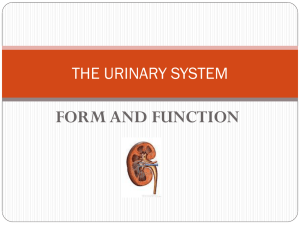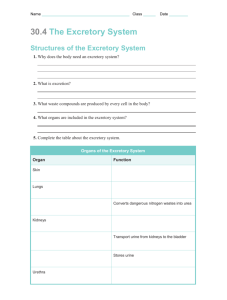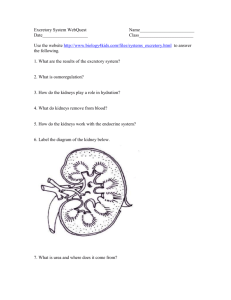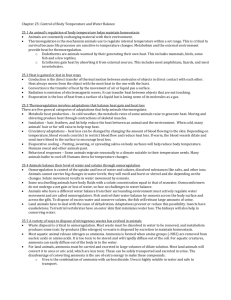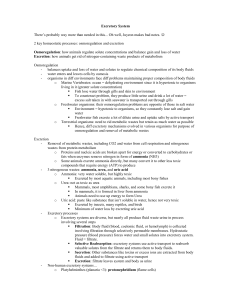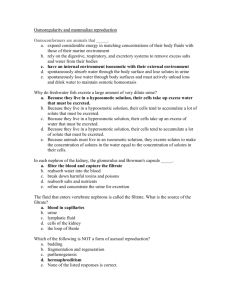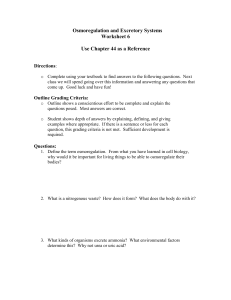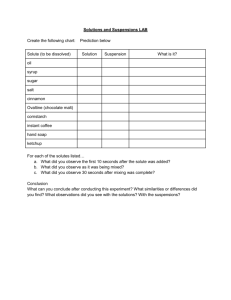Ch. 44 (word) - LTCConline.net
advertisement
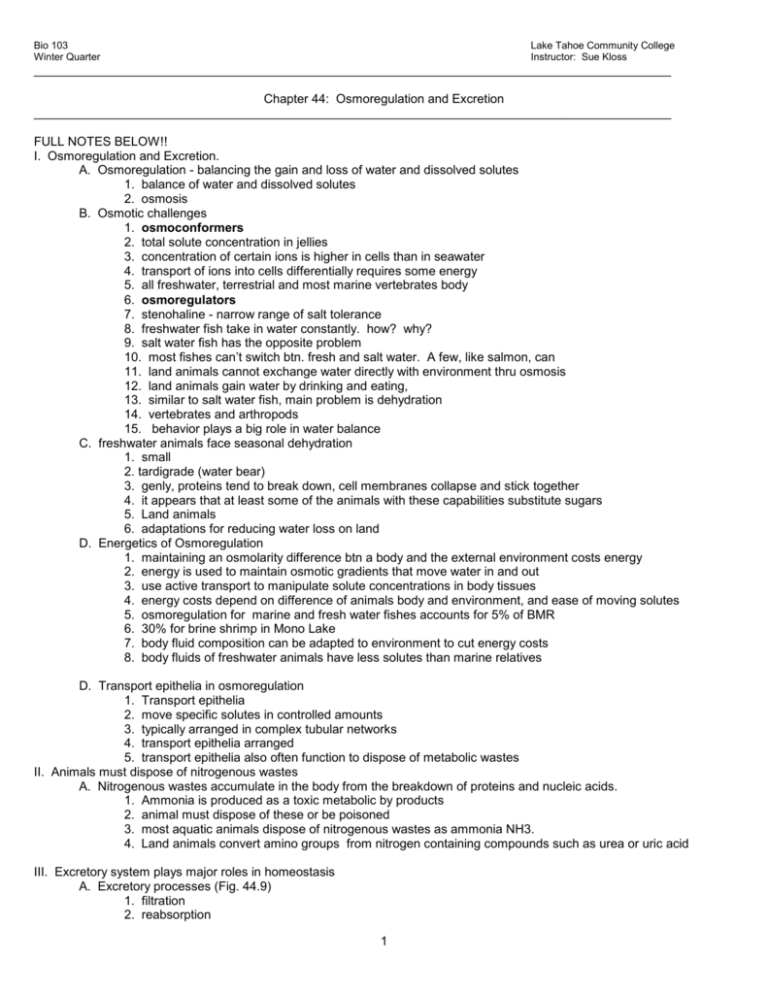
Bio 103 Winter Quarter Lake Tahoe Community College Instructor: Sue Kloss ____________________________________________________________________________________________ Chapter 44: Osmoregulation and Excretion ____________________________________________________________________________________________ FULL NOTES BELOW!! I. Osmoregulation and Excretion. A. Osmoregulation - balancing the gain and loss of water and dissolved solutes 1. balance of water and dissolved solutes 2. osmosis B. Osmotic challenges 1. osmoconformers 2. total solute concentration in jellies 3. concentration of certain ions is higher in cells than in seawater 4. transport of ions into cells differentially requires some energy 5. all freshwater, terrestrial and most marine vertebrates body 6. osmoregulators 7. stenohaline - narrow range of salt tolerance 8. freshwater fish take in water constantly. how? why? 9. salt water fish has the opposite problem 10. most fishes can’t switch btn. fresh and salt water. A few, like salmon, can 11. land animals cannot exchange water directly with environment thru osmosis 12. land animals gain water by drinking and eating, 13. similar to salt water fish, main problem is dehydration 14. vertebrates and arthropods 15. behavior plays a big role in water balance C. freshwater animals face seasonal dehydration 1. small 2. tardigrade (water bear) 3. genly, proteins tend to break down, cell membranes collapse and stick together 4. it appears that at least some of the animals with these capabilities substitute sugars 5. Land animals 6. adaptations for reducing water loss on land D. Energetics of Osmoregulation 1. maintaining an osmolarity difference btn a body and the external environment costs energy 2. energy is used to maintain osmotic gradients that move water in and out 3. use active transport to manipulate solute concentrations in body tissues 4. energy costs depend on difference of animals body and environment, and ease of moving solutes 5. osmoregulation for marine and fresh water fishes accounts for 5% of BMR 6. 30% for brine shrimp in Mono Lake 7. body fluid composition can be adapted to environment to cut energy costs 8. body fluids of freshwater animals have less solutes than marine relatives D. Transport epithelia in osmoregulation 1. Transport epithelia 2. move specific solutes in controlled amounts 3. typically arranged in complex tubular networks 4. transport epithelia arranged 5. transport epithelia also often function to dispose of metabolic wastes II. Animals must dispose of nitrogenous wastes A. Nitrogenous wastes accumulate in the body from the breakdown of proteins and nucleic acids. 1. Ammonia is produced as a toxic metabolic by products 2. animal must dispose of these or be poisoned 3. most aquatic animals dispose of nitrogenous wastes as ammonia NH3. 4. Land animals convert amino groups from nitrogen containing compounds such as urea or uric acid III. Excretory system plays major roles in homeostasis A. Excretory processes (Fig. 44.9) 1. filtration 2. reabsorption 1 B. C. D. E. 3. secretion 4. excretion Survey of animal excretory systems 1. protonephridia 2. Metanephridia 3. Malpighian tubules 4. Vertebrates have kidneys Human excretory system 1. excretory system forms and excretes urine 2. our 2 kidneys 3. each kidney is filled 4. human body y 5. each day, kidneys extract ~ 45 gallons of 6. kidneys refine the filtrate, 7. “plumbing plan of a human” 8. kidney has 2 main regions 9. each kidney contains 1000,000 functional units. 10. Bowman’s capsule surrounds a ball of capillaries called a glomerulus. 11. intimate association between blood vessels and nephrons is key to function 12. each nephron has 2 distinct beds of capillaries Functions of the excretory system - filtration, reabsorption, secretion and excretion Closer look - single nephron 1. reabsorption and secretion from the blood 2. filtrate 3. small molecules and ions travel from tubules and capillaries passing thru interstitial fluid during reabsorption and secretion 4. reabsorption, secretion 5. active transport and passive transport occur (osmosis) 6. interstitial fluids are more concentrated w/ solutes closer to the inner medulla, lowest in the cortex. 7. this solute gradient allows the kidney to extract and filter most of the water from the filtrate 8. osmosis moves water out of kidney into interstitial fluids 9. cells of proximal and distal tubule reabsorb NaCl. 10. proximal tubule also reabsorbs water, glucose, amino acids. 11. distal tubule secretes drugs, like penicillin, that circulates in the blood 12. loop of Henle and collecting duct have one function- reabsorption of water 13. NaCl and urea are sometimes reabsorbed 14. loop of Henle goes deep into medulla to give up water to the higher solute concentration gradient 15. At hairpin loop, water can no longer pass through tubule (impermeable). 16. final refining of filtrate occurs in collecting duct in medulla. 17. When solute concentrations in of body fluids rises above a set point, a control center in brain increases a hormone called ADH 18. When body fluid solutes are diluted below set point, like when we drink too much water, blood levels of ADH drop Lesson Objectives Ch. 44 1. Define osmoregulation and excretion. 2. Define Define osmolarity and distinguish among isoosmotic, hyperosmotic, and hypoosmotic solutions. 3. Distinguish between osmoregulators and osmoconformers. Explain why osmoregulation has an energy cost. 4. Distinguish between stenohaline and euryhaline animals, and explain why euryhaline animals include both osmoconformers and osmoregulators. 5. Discuss the osmoregulatory strategies of marine animals. 6. Explain how the osmoregulatory problems of freshwater animals differ from those of marine animals. 7. Describe anhydrobiosis as an adaptation that helps tardigrades and nematodes to survive periods of dehydration. 2 8. Describe some adaptations that reduce water loss in terrestrial animals. 9. Describe the ultimate function of osmoregulation. Explain how hemolymph and interstitial fluids are involved in this process. 10. Explain the role of transport epithelia in osmoregulation and excretion. 11. Describe the production and elimination of ammonia. Explain why ammonia excretion is most common in aquatic species. 12. Compare the strategies to eliminate waste as ammonia, urea, or uric acid. Note which animal groups are associated with each process and why a particular strategy is most adaptive for a particular group. 13. Compare the amounts of nitrogenous waste produced by endotherms and ectotherms, and by predators and herbivores. 14. Describe the key steps in the process of urine production. 15. Describe how a flame-bulb (protonephridial) excretory system functions. 16. Explain how the metanephridial excretory tubule of annelids functions. Compare the structure to the protonephridial system. 17. Describe the Malpighian tubule excretory system of insects. 18. Using a diagram, identify and give the function of each structure in the mammalian excretory system. 19. Using a diagram, identify and describe the function of each region of the nephron. 20. Describe and explain the relationships among the processes of filtration, reabsorption, and secretion in the mammalian kidney. 21. Explain how the loop of Henle enhances water conservation by the kidney. 22. Explain how the loop of Henle functions as a countercurrent system. FULL NOTES CH 44 I. Osmoregulation and Excretion - Many animals can tolerate wide fluctuations in body temps, but not much range in relative amounts of dissolved solutes and water in their internal fluids. A. Osmoregulation - balancing the gain and loss of water and dissolved solutes 1. metabolic reactions require a precise balance of water and dissolved solutes, which include ions like Na+, Chloride, K+, Ca2+ , bicarbonate (HCO3-) 2. osmosis occurs whenever 2 liquids separated by semipermeable membrane differ in total solute concentration a. this is called osmolarity, moles of solute/liters of solution 1. expressed in our boook as millimoles of solute/L (mosm/L) 2. osmolarity of human blood is 300 mosm/L, vs seawater at 1000 mosm/L 3. terms hypoosmotic, hyperosmotic and isoosmotic refer to solutions, while hypertonic etc. refer to response of animal cells b. net movement of water from hypotonic to hypertonic solution until solute concentrations are even c. whether terrestrial, salt or freshwater, animals can not survive change in net water loss or gain that alters concentration of dissolved solutes d. cells burst if net uptake of water e. shrivel and die if net loss of water 3. terrestrial animals, including humans take in water in food and drink; 4. losses through urine and evaporation (sweat and breathing) 5. evaporation unimportant for aquatic animals 3 6. aquatic animals that live in the sea have fluids with solute concentration the same as sea water called osmoconformers - no net gain/loss of water 7. total solute concentration in jellies, scallops, lobsters, and most marine invertebrates is equal to sea water; very little energy required. 8. concentration of certain ions is higher in cells than in seawater, and usually higher than in interstitial fluids e.g. potassium - very important in cell membrane function 9. transport of ions into cells differentially requires some energy 10. all freshwater, terrestrial and most marine vertebrates body fluids with solute concentration diff’t from their environment; they use energy in controlling water loss or gain 11. osmoregulators use energy in controlling water loss/gain 12. stenohaline - narrow range of salt tolerance a. euryhaline - broad range of salt tolerance 1. tilapia- from fresh water to 2x ocean water (Fig. 44.2) 13. freshwater fish take in water constantly. (Fig. 44.3) how? why? a. 3 organ systems help achieve correct water balance b. digestive system takes in ions from food c. gills take up salt ions, especially Na+ and Cld. kidneys constantly produce dilute urine - much lower solute concentration than internal fluids 14. salt water fish has the opposite problem a. internal fluids must be lower in total solutes than seawater. b. drinks seawater and pumps the excess salt out through gills. Also produces little urine, of the same concentration as body fluids 15. most fishes can’t switch btn. fresh and salt water. A few, like salmon, can a. in the ocean they drink seawater and excrete excess salt like a cod b. in freshwater for spawning, cease drinking and take up salts through gills 16. land animals cannot exchange water directly with environment thru osmosis 17. land animals gain water by drinking and eating, and lose water by sweat, evaporation and urine 18. similar to salt water fish, main problem is dehydration 19. big problem- may be why for most part only two groups of animals have adapted- vertebrates and arthropods a. arthropods have exoskeletons impregnated with wax, vertebrates have skin b. eggs provide watery environment for embryo - shells, amniotic sacs conserve water 20. behavior plays a big role in water balance, and so do kidneys B. freshwater animals face seasonal dehydration 1. small invertebrates that live on plants, seasonal waters or moist soils usually lay eggs to bypass the dry season. 2. tardigrade (water bear) eats moss juices. When dry season comes, he loses 95% of its water; almost like being freeze dried, may remain dormant for decades. A few minutes after being rehydrated, he will be up and lumbering around feeding (fig. 44.4) a. anhydrobiosis - lose body water and survive in a dormant state when environmnet dries out 3. proteins tend to break down, cell membranes collapse and stick together when they dry out 4. it appears that at least some of the animals with these capabilities substitute sugars for the water that protects proteins and membranes a. disaccharide called trehalose seems to protect the cells by replacing the water that is normally associated with membranes and proteins b. many insects that survive freezing in the winter use trehalose as a membrane protectant 5. Land animals - humans die if they lose about 12% of their water content, animals adapted for dry conditions such as camels can withstand about 2x that much 6. adaptations for reducing water loss on land a. waxy layers on insects, shells of snails, dead, keratinized layers of skin cells on vertebrates b. nocturnal habits in desert- behavioral c. land animals drink, and eat moist food, use water derived from metabolism - cell respiration d. kangaroo rat vs, humans (fig. 44.5) 7. Transport epithelia - layer of epithelial cells that regulate solute movements, essential components of osmotic regulation and metabolic waste disposal - eg salt glands in marine birds (Fig. 44.7) C. Animals must dispose of nitrogenous wastes 1. nitrogenous wastes accumulate in the body from the breakdown of proteins and nucleic acids. these are toxic metabolic by products 2. animal must dispose of these or be poisoned 3. most aquatic animals dispose of nitrogenous wastes as ammonia NH3. It simply diffuses into surrounding water (Fig. 44.8) a. planaria excrete it across whole body surface 4 b. fish excrete it from gills c. forms from amino groups removed from proteins and nucleic acids d. its very toxic, raises pH and interferes with membrane transport e. too toxic to be stored in body, but diffuses rapidly across cell membranes in water. diffusion too slow in air for use by terrestrial animals 4. Land animals convert amino groups from nitrogen containing compounds such as urea or uric acid a. these can be safely stored and transported through body to be excreted periodically b. disadvantage- animals must use energy to convert aminos to urea or u.a., but not to ammonia c. urea is 100,000 x less toxic than ammonia, so it can be concentrated and excreted with little water loss d. some animals, like toads, can switch btn excreting wastes as urea or ammonia, depends on if they are in water or on land. e. urea requires water to excrete urea in solution. f. uric acid, (secreted by birds, insects, many reptiles, snails and some amphibs) avoids water loss problem completely - it can be excreted as a crystal, very concentrated. g. considerably more complex molecule than urea, 1000x less soluble in water than NH3 or urea h. higher cost in energy to excrete uric acid, but lower cost in water II. Excretory system plays major roles in homeostasis A. Excretory processes (Fig. 44.9) 1. filtration - water and all small molecules forced thru capillary wall into nephron tubule from glomerulus 2. reabsorption - water and valuable solutes including glucose, salts, amino acids reclaimed from filtrate and returned to blood 3. secretion - certain substances removed from blood and added to filtrate. e.g. excess K+, H+. Removal of hydrogen ions keeps blood from getting too acidic. Secretion also eliminates certain drugs and toxic substances from blood 4. excretion - urine, the product of filtration, reabsorption and secretion, passes from kidneys to the outside via ureters, urinary bladder, urethra B. Survey of animal excretory systems 1. protonephridia - flame bulb systems (Flatworms - Fig. 44.10) a. network of dead end tubules lacking internal openings b. smallest tubules capped by cellular units called flame bulbs c. tuft of cilia projects into tubule (flame) d. beating of cilia draws water and solutes from interstitial fluids into tubule e. moves urine outward thru tubultes ontil they empty to external environment thru nephridiopore f. mainly for osmotic regulation, metabolic wastes mostly diffuse across body surface g. protonephridia also found in rotifers, some annelids, larvae of molluscs and lancelets 2. Metanephridia - have internal openings that collect body fluids (Fig. 44.11) a. most annelids have this b. immersed in coelomic fluids enveloped by a capillary network c. internal opening of metanephridium is surrounded by ciliated funnel, the nephrostome d. fluid enters nephrostomepasses thru coiled collecting tubule, which includes a storage bladder that opens to the outside thru nephridiopore e. earthworm’s metanephridia has both excretory and osmoregulatory function f. as urine moves thru tubule, transport epithelium bodering lumen reabsorbs solutes and passes them back to the blood 3. Malpighian tubules (fig. 44.12) a. insects and terrestrial arthropods - remove N wastes and regulate water balance b. M tubules dead in digestive tract end in tips immersed in hemolymph (circulatory fluid, difft than blood) c. transport epithelium lining tubules secretes certain solutes, including N wastes, from hemolymph into lumen d. water follows solutes in e. in rectum, most solutes pumped back to hemolymph f. water again follows solutes, and waste is secreted as nearly dry matter along w/ feces g. tremendously efficient, water wise, allowed insects to colonize land 4. Vertebrates have kidneys - next section details human kidneys C. Human excretory system 1. excretory system forms and excretes urine and regulates the amount of water and salts in bodily fluids 2. our 2 kidneys, each the size of fists, are main processing centers 3. each kidney is filled with about 80 km of tubules and capillary network 4. human body = ~5 l. of blood, but circulates repeatedly. kidneys circulate about 1100-2000 l. (400 -450 gallons) each day 5 5. each day, kidneys extract ~ 45 gallons of filtrate = water, urea and solutes (Na+, K+, Cl-, HCO3- and glucose and amino acids 6. kidneys refine the filtrate, concentrating the urea and returning most of the water and solutes to the blood. We excrete about 1.5 l/day 7. Fig. 44.13 - “plumbing plan of a human” a. blood enters kidneys via renal artery b. filtered blood leaves kidneys via renal veins c. urine leaves each kidney via a duct called ureter, passes into urinary bladder, emptied in urination d. urine leaves body thru tube - urethra - near vagina or in penis 8. Fig. 44.14 - kidney has 2 main regions a. renal cortex - outer layer b. renal medulla 1. inner region 2. outer region c. from medulla, urine flows into chamber called renal pelvis, and from there to ureter 9. Fig. 44.14 - each kidney contains 1000,000 functional units called nephrons. a. consists of tubule, and associated blood vessels b. acts like a mini kidney - extracts tiny amt. of filtrate from blood, then refines to a much smaller amt. of urine c. each nephron starts and ends in kidneys cortex. some extend into medulla d. collecting end of nephron has a bulb swelling called Bowman’s capsule. The other end is the collecting duct, which carries urine into the renal pelvis 10. Bowman’s capsule surrounds a ball of capillaries called a glomerulus. Capsule and glomerulus together make up blood filtering unit a. blood pressure forces water and solutes from blood in glomerulus capillaries across the wall of Bowman’s capsules and into the nephron tubules b. blood cells and macromolecules stay in capillaries c. rest of nephron refines the filtrate - 3 sections of tubule1) proximal tube (in cortex) 2) loop of Henle- hairpin loop carrying filtrate toward or into medulla then back to cortex 3) distal tubule (distal to Bowman’s capsule) d. distal tubule empties filtrate into a collecting duct which receives filtrate from many nephrons e. filtrate becomes urine while passing through collecting duct f. all collecting ducts empty into renal pelvis, then to ureter 11. intimate association between blood vessels and nephrons is key to function 12. each nephron has 2 distinct beds of capillaries a. in glomerulus b. surrounding nephron tubule surrounding loops of Henle called vasa recta (Fig. 44.13) c. these converge to form a small branch of renal vein E. Functions of the excretory system - filtration, reabsorption, secretion and excretion F. Closer look - single nephron and collecting duct producing urine from a large amount of water and valuable solutes along with waste molecules (Fig. 44.15) 1. black arrows are reabsorption and secretion from the blood (not shown) 2. blue fluid - filtrate 3. small molecules and ions travel from tubules and capillaries passing thru interstitial fluid during reabsorption and secretion 4. purple arrows - reabsorption, secretion 5. active transport and passive transport occur (osmosis) - red and purple arrows 6. interstitial fluids are more concentrated w/ solutes closer to the inner medulla, lowest in the cortex. 7. this solute gradient allows the kidney to extract and filter most of the water from the filtrate 8. osmosis moves water out of kidney into interstitial fluids 9. cells of proximal and distal tubule reabsorb NaCl. They secrete some poisons, like ammonia; they release some H+ ions into the blood and reabsorb some HCO3- to regulate blood pH 10. proximal tubule also reabsorbs water, glucose, amino acids. 11. distal tubule secretes drugs, like penicillin, that circulates in the blood 12. loop of Henle and collecting duct have one function- reabsorption of water 13. NaCl and urea are sometimes reabsorbed to maintain concentration gradient in the interstitial fluids, but only to increase the water reabsorption 14. loop of Henle goes deep into medulla to give up water to the higher solute concentration gradient before coming back to the collecting ducts in the cortex. capillaries removes the blood immediately so it doesn't interfere with the concentration gradient. 6 15. At hairpin loop, water can no longer pass through tubule (impermeable). As filtrate moves back toward cortex, NaCl is reabsorbed from it. At first it is passive, then active. More water leaves the upper collecting duct since solute concentration gradient is again high. 16. final refining of filtrate occurs in collecting duct in medulla. The collecting duct in the medulla is permeable to urea so some leaks out into interstitial fluids; more water is reabsorbed before urine passes into renal pelvis 17. When solute concentrations in of body fluids rises above a set point, a control center in brain increases a hormone called ADH (antidiuretic hormone) in blood. ADH signals the nephrons to reabsorb more water from the filtrate. 18. When body fluid solutes are diluted below set point, like when we drink too much water, blood levels of ADH drop making nephrons reabsorb less water. Other hormones aid in water balance and homeostasis, 7
